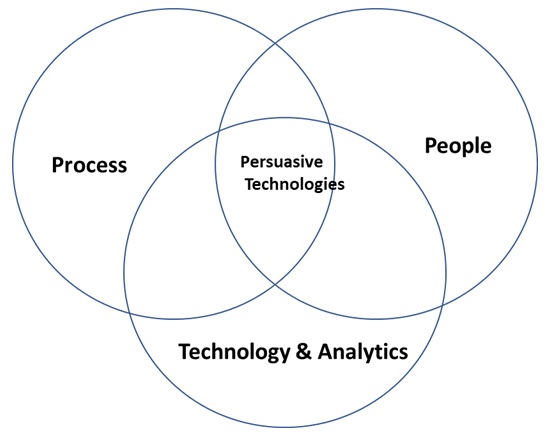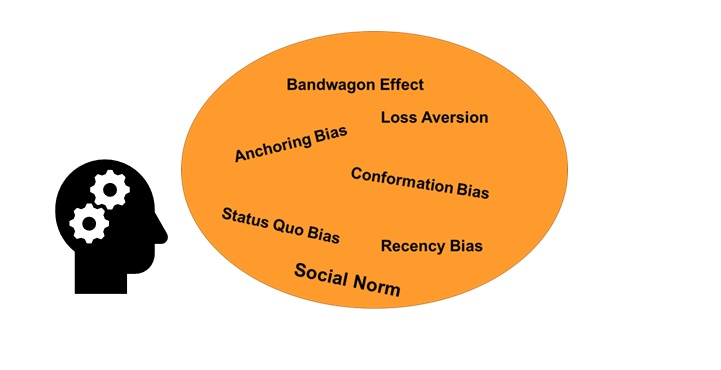
– Nachiket Vaidya (PGP 2013)
Welcome Dear Fellow WIMWIAN!
You are most probably reading this article because it says that its read by almost everyone else! And of course, you are not alone, you were drawn in due to a phenomenon called FOMO!! (Fear Of Missing Out) It is one of the most frequently used cognitive biases used by marketers in promoting their products. Now that we have your attention, let’s start the subject!
While playing pool, we are all using Newtonian dynamics but very few of us understand its complexities & principles – but wait but does it matter?
No, it doesn’t! That’s true and same is the case with Behaviour Science and Psychology. We all use psychological biases quite often, to persuade others, get their time, influence decisions and so on. Unlike before, with the advent of digital technologies, mobile revolution tracking human activities and behaviors has become extremely simple and hence the new field of Behaviour design is emerging into the arena.

The idea isn’t new and probably dates back to 1990s when B. J. Fogg – Stanford researcher coined the term “persuasive technology” which theorises how Human behavior can be influenced and how technology can facilitate the interactions. Many companies today have gone one step ahead and using technologies not only in traditional B2C context to drive consumer habits but also to persuade & change employee behavior to create a “WIN – WIN”.
What do Experts say?
The truth is that Persuasive Technologies such as Gameful Design OR Gamification, Design Thinking, Habit Forming products & Technologies have already surpassed the hype cycle, however, there are many other persuasive technologies are gradually catching up.
Some of the key assumptions and predictions for Gartner last year include,
- By 2018, a major software vendor will incorporate into its portfolio persuasive capabilities that motivate people to change their attitudes and behaviors.
- By 2020, algorithms will positively alter the behavior of over 1 billion global workers.
- An emerging set of “persuasive technologies” leverages big data from myriad sources, mobile, IoT devices and deep analysis to positively influence behavior without coercion, ideally in a relationship of mutual benefit.
(Did I tell you that – I just primed you with social Bias?? ..)
What does it mean for enterprises?
Very clearly with more and more millennials adding to the workforce, the enterprise applications & systems are being forced to go through the Cycle of evolution!
Traditionally, People, Process, and Technology have been the 3 key levers for enterprise optimisation and success. Today it has become more advanced with the advent of Tools such as bots, AI, User Centric Approach, Gamification, Neuro Science & Behavioural Economics.
What difference is it making?
Well while many companies are yet to catch up, most of the Persuasive Technologies are in predominantly in customer engagement & retention, recruitment, innovation management, Sales & CRM, employee engagement, Supply chain management – AND the list is ever growing!
Many of the traditional problems which exist due to behaviors, change management & alignment seem to have a great impact using Digital Nudges. But what are these digital Nudges?
“A nudge, as we will use the term, is any aspect of the choice architecture that alters people’s behavior in a predictable way without forbidding any options or significantly changing their economic incentives. To count as a mere nudge, the intervention must be easy and cheap to avoid. Nudges are not mandates. Putting fruit at eye level counts as a nudge. Banning junk food does not.” (Thaler & Sunstein 2008, p. 6)
In the famous book “Nudge – Improving Decisions about Health, Wealth and Happiness (2008)” Richard Thaler and Cass Sunstein suggested that if a particular decision making patter or behavioural pattern is the result of biases/habits – then it’s possible to change it by “Nudging” towards better option via similar structure of biases, habits into choice architecture surrounding the behaviour. It’s not surprising that Economist Richard Thaler’s “Nudge Theory” has been recognised as landmark achievement and is recognised as “bridge between the economic and psychological analyses of individual decision-making”.
What role does experimentation play in these emerging fields? Human Behaviour is Predictably Unpredictable
When do people get moved by rational persuasion? Is reminding them good enough? What time is best to get them to act? Do we send a digital nudge on SMS or is it best to send it over email ? … the missing variables go on… !
Well, human beings are sometimes rational, sometimes emotional , sometimes driven by intrinsic or extrinsic motivations – and as you guessed it, in spite of advanced tools including AI – it is very difficult to predict accurately – hence experimentation with fundamental assumptions becomes key to faster success here.
So how are companies doing it?
Even if you exclude giants like Facebook , Google , Microsoft , Amazon and others who are extremely evolved in the digital world , various start-ups are no less when it comes to behaviour focussed products. Very often you would see Uber, Ola /other aggregators running A/B testing experiments on users to get their behaviour preferences with complex algorithm running in the background. Team of business experts , analyst , product champions and data scientist solving the puzzle together.
Even in the context of enterprise persuasive technologies with design problem to accommodate for organisational culture , hierarchies , employee motivations and so on – it’s a mammoth task built on top of experiments linking theory to practice with the help of analytics !
So will my employees achieve targets this month or not ? What’s the percentage of risk ?
With the accumulation of more and more data on top of AI & Machine learning techniques, many such questions would start getting accurate and predictable answers very soon.
“ A heart can no more be forced to love than a stomach can be forced to digest food by persuasion” – Alfred Nobel
While we know persuasive technologies isn’t a silver bullet , however, it is definitely looks very promising considering the huge potential it has and the gap that exists . It goes without saying that its definitely a much needed tool to engage , drive and motivate the world workforce which averages only at 13% of engaged employees currently!
ITS TIME TO CHANGE THE SOCIAL NORM!



Sorry, the comment form is closed at this time.